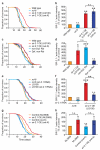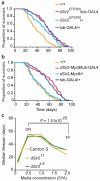Absence of effects of Sir2 overexpression on lifespan in C. elegans and Drosophila
- PMID: 21938067
- PMCID: PMC3188402
- DOI: 10.1038/nature10296
Absence of effects of Sir2 overexpression on lifespan in C. elegans and Drosophila
Abstract
Overexpression of sirtuins (NAD(+)-dependent protein deacetylases) has been reported to increase lifespan in budding yeast (Saccharomyces cerevisiae), Caenorhabditis elegans and Drosophila melanogaster. Studies of the effects of genes on ageing are vulnerable to confounding effects of genetic background. Here we re-examined the reported effects of sirtuin overexpression on ageing and found that standardization of genetic background and the use of appropriate controls abolished the apparent effects in both C. elegans and Drosophila. In C. elegans, outcrossing of a line with high-level sir-2.1 overexpression abrogated the longevity increase, but did not abrogate sir-2.1 overexpression. Instead, longevity co-segregated with a second-site mutation affecting sensory neurons. Outcrossing of a line with low-copy-number sir-2.1 overexpression also abrogated longevity. A Drosophila strain with ubiquitous overexpression of dSir2 using the UAS-GAL4 system was long-lived relative to wild-type controls, as previously reported, but was not long-lived relative to the appropriate transgenic controls, and nor was a new line with stronger overexpression of dSir2. These findings underscore the importance of controlling for genetic background and for the mutagenic effects of transgene insertions in studies of genetic effects on lifespan. The life-extending effect of dietary restriction on ageing in Drosophila has also been reported to be dSir2 dependent. We found that dietary restriction increased fly lifespan independently of dSir2. Our findings do not rule out a role for sirtuins in determination of metazoan lifespan, but they do cast doubt on the robustness of the previously reported effects of sirtuins on lifespan in C. elegans and Drosophila.
© 2011 Macmillan Publishers Limited. All rights reserved
Figures


Comment in
-
Ageing: longevity hits a roadblock.Nature. 2011 Sep 21;477(7365):410-1. doi: 10.1038/477410a. Nature. 2011. PMID: 21938058 No abstract available.
-
Model organisms: the dangers lurking in the genetic background.Nat Rev Genet. 2011 Oct 18;12(11):742. doi: 10.1038/nrg3089. Nat Rev Genet. 2011. PMID: 22005981 No abstract available.
-
Ageing: a midlife crisis for sirtuins.Nat Rev Mol Cell Biol. 2011 Oct 21;12(11):688. doi: 10.1038/nrm3218. Nat Rev Mol Cell Biol. 2011. PMID: 22016053 No abstract available.
References
Additional references
-
- Sulston J, Hodgkin J. In: The nematode Caenorhabditis elegans. Wood WB, editor. Cold Spring Harbor; 1988. pp. 587–606.
-
- Kamath R, et al. Systematic functional analysis of the Caenorhabditis elegans genome using RNAi. Nature. 2003;421:231–237. - PubMed
References
-
- Tissenbaum HA, Guarente L. Increased dosage of a sir-2 gene extends life span in Caenorhabditis elegans. Nature. 2001;410:227–230. - PubMed
-
- Viswanathan M, Kim SK, Berdichevsky A, Guarente L. A role for SIR-2.1 regulation of ER stress response genes in determining C. elegans life span. Dev Cell. 2005;9:605–615. - PubMed
-
- Partridge L, Gems D. Benchmarks for ageing studies. Nature. 2007;450:165–167. - PubMed
Publication types
MeSH terms
Substances
Grants and funding
LinkOut - more resources
Full Text Sources
Other Literature Sources
Molecular Biology Databases
Miscellaneous

